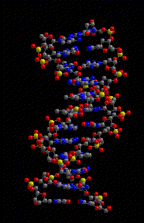When most of us think of deoxyribonucleic acid (DNA), we picture something like the graphic at the right – the neat, tidy double helix. In reality, this double helix consists of two very long curves intertwined millions of times. The DNA strand is only a few molecules wide, but sever al centimeters long, tightly coiled inside the nucleus of every cell in our bodies.
al centimeters long, tightly coiled inside the nucleus of every cell in our bodies.
To give you a more accurate picture of what real DNA looks like, imagine the nucleus of a cell scaled up to the size of a basketball. The DNA strand then scales to the width of thin fishing line – about 200 km (120 miles) in length – packed inside our basketball nucleus. In this tremendous scale, we can easily imagine that the DNA strand could become tangled and knotted in such a cramped space.
In reality, that is exactly the case. The problem comes when it is time for the DNA to replicate to form another cell. If you remember from your health class, the double helix of DNA has to split in two to complete the process of cell division. When the strand becomes knotted, the DNA cannot separate intact at crossings in the knot (just as you cannot completely untangle a trefoil knot without cutting it). In order for the DNA to separate, replicate, and recombine, special enzymes in the nucleus actually “cut” the DNA strand so replication can occur and then reattach the loose ends once the crossing is resolved.
The particular fascination in this process for geneticists is the fact that chemical changes occur in the DNA strand as a result of this process. Changes in the DNA structure due to the actions of these enzymes have required geneticists to use very advanced mathematical topology (which includes knot theory) and geometry in their study of molecular biology.
Geneticists have discovered that DNA can form knots and links which can be described mathematically as we have discussed them in the introduction and advanced pages. By understanding knot theory more completely, scientists are becoming more able to comprehend the massive complexity involved in the life and reproduction of the cell. More knowledge of knots and their properties may hold one of the keys to unlocking the mystery of DNA in the new millenium.
If you are interested in reading more specific information on the connection knot theory has with DNA, the following article from Notices of the American Mathematical Society provides a very thorough treatment of the mathematics and chemistry behind geneticists’ study of the process, and was used as a reference for the information on this page:
Sumners, De Witt. Lifting the Curtain: Using Topology to Probe the Hidden Action of Enzymes. Notices of the American Mathematical Society (42), 5, May 1995.
The following book by Colin Adams has an excellent chapter on the importance of knot theory in biology, chemistry, and physics, and was also used as a reference:
Colin C. Adams, The Knot Book: An Elementary Introduction to the Mathematical Theory of Knots, W.H. Freeman and Company, Oxford, 1994.
Either of these resources would be a great place to learn more about how we can use an interesting and growing field of mathematical study to enhance our understanding of valuable real-world processes.

